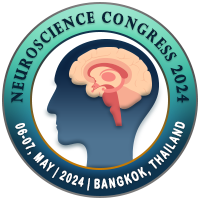
Diana Oliveira
Centro Hospitalar de Entre Douro e Vouga, PortugalTitle: Oromandibular dystonia: differential diagnosis and management
Abstract
Oromandibular dystonia is a focal dystonia characterized by involuntary movements affecting the jaw, oropharynx, lips, and tongue. It may arise as a side effect of certain medications, and its clinical diagnosis is crucial. Treatment options vary from addressing underlying causes to medication, physiotherapy, botulinum toxin injections, and afferent muscle block. Meige's syndrome, marked by oromandibular dystonia and blepharospasm, has an idiopathic etiology. While there's no cure, symptomatic relief is achievable through medications. A 70-year-old man was referred to our center with Meige's syndrome diagnostic, with 5 and a half years of evolution, for botulinum toxin-A (BoNT-A) injection. The patient reported progressive worsening of involuntary facial movements, involving the lower half of the face and physical examination revealed oromandibular dystonia with an Oromandibular Dystonia Rating Scale (OMDRS) score of 177. Standard blood tests and imaging showed no abnormalities. The patient's history included six years of methotrexate use for psoriatic arthritis. Considering the timeline, a possible association between methotrexate and delayed dystonia was explored, leading to a switch to sulfasalazine. Subsequently, the patient's condition improved, supported by a declining OMDRS score from 177 to 103. BoNT-A injection further enhanced outcomes, with an OMDRS score of 75 after eight weeks. The case challenges the initial Meige's syndrome diagnosis due to the absence of blepharospasm. Exploration of the patient's history revealed a temporal relationship between methotrexate initiation and dystonia development, prompting a reevaluation. While a direct link between methotrexate and oromandibular dystonia lacks definitive evidence, case reports suggest a potential association. The patient's improvement post-methotrexate withdrawal underscores the importance of considering medication-induced adverse effects in dystonia cases. The prognosis remains uncertain, but symptomatic control through botulinum toxin injections and speech therapy offers management options. Pending further evidence, oromandibular dystonia should be recognized as a potential secondary effect of methotrexate.
Biography
Diana Oliveira completed her master's degree in medicine in 2020 at the abel salazar biomedical sciences institute in portugal. Currently, she is undergoing medical residency in physical medicine and rehabilitation. She has authored 2 articles in scientific journals, delivered 12 oral presentations, presented 18 posters, and actively participated in numerous conferences and courses.

